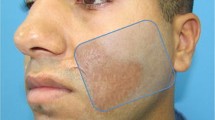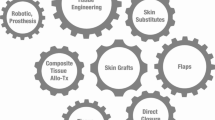Abstract
Background
Tissue expansion is a simple yet versatile surgical technique. Skin defects come in a variety of shapes and dimensions, and in specific reconstructive situations, the catalogued tissue expanders may be of limited suitability producing expanded skin that is not readily compatible with the defect leading to additional scarring and unsatisfactory results. In patients with specific requirements, we have successfully used specially designed tissue expanders to facilitate the reconstruction with reduced morbidity. The aim of the study was to present our experience, indications and outcome of custom-made tissue expanders in resurfacing defects in areas with limited tissue availability.
Methods
Thirty-two textured custom-made tissue expanders were used in 16 patients for skin defects. Indications included eight traumas and eight congenital defects. Custom-made tissue expanders with specified locations for the valves were used in combination with advancement of skin to suit specific reconstructive requirements and minimize scarring.
Results
Custom-made tissue expanders are ideal in certain circumstances to improve the quality of skin reconstruction with reduced morbidity. Skin necrosis was seen in one smoking patient.
Conclusions
In specific reconstructive situations where catalogued tissue expanders are not suitable, custom-made tissue expanders are preferable to optimize results of skin reconstruction with minimal added cost.
Level of Evidence: Level IV, therapeutic study.





Similar content being viewed by others
References
Radovan C (1978) Reconstruction of the breast after radical mastectomy using temporary expander. Am Soc Plast Reconstr Surg Forum 1:41
Radovan C (1980) Advantages and complications of breast reconstruction using temporary expander. Am Soc Plast Reconstr Surg Forum 3:63
Radovan C (1982) Breast reconstruction after mastectomy using temporary expander. Plast Reconst Surg 69:195–208
Radovan C (1994) Tissue expansion in soft tissue reconstruction. Plast Reconstr Surg 74:482–492
Tonnard PL, Monstrey SJ, Van Landuyt KH, Blondeel PN, Matton GE (1998) A simple mathematical formula for custom-made croissant tissue expanders. Ann Plast Surg 41(3):246–251
Spence RJ (1988) Clinical use of a tissue expander-enhanced transposition flap for face and neck reconstruction. Ann Plast Surg 21:58–64
Joss GS, Zoltie N, Chapman P (1990) Tissue expansion technique and the transposition flap. Br J Plast Surg 43:328–333
Zide BA, Krap NS (1992) Maximizing gain from rectangular tissue expanders. Plast Reconstr Surg 90:500–505
Wieslander JB (1991) Tissue expansion in the head and neck: a 6 year review. Scand J Plast Reconstr Surg Hand Surg 25:47–56
Borges-Filho PT, Neves RI, Gemperil R (1991) Soft tissue expansion in lower extremity reconstruction. Clin Plast Surg 18:593–599
Theunis PG, Masser MR (1991) Surgical delay of expanded skin in upper extremity reconstruction. Br J Plast Surg 44:266–269
Carneiro R, Dichirara J (1991) A protocol for tissue expansion in upper extremity reconstruction. J Hand Surg 16:147–151
Hata Y, Umeda T (2000) Reconstruction of congenital microtia by using a tissue expander. J Med Dent Sci 47(2):105–116
Morgan RF, Edgerton MT (1985) Tissue expansion in reconstructive hand surgery: case report. J Hand Surg (Am Volume) 10(5):754–757
Chun JT, Rohrich RJ (1998) Versatility of tissue expansion in head and neck reconstruction. Ann Plast Surg 41(1):11–16
Manders EK, Schenden MJ, Furrey JA (1984) Soft tissue expansion: concepts and complications. Plast Reconstr Surg 74(4):493–507
Neale HW, High RM, Billimire DA (1988) Complications of controlled tissue expansion in the pediatric patient. Plast Reconstr Surg 82(5):840–845
Still JM, Law E, Craft-Coffman B (2000) Skeletal deformities due to tissue expanders: report of two patients. Ann Plast Surg 44(2):271–273
Marcus J, Horan DB, Robinson JK (1990) Tissue expansion: past, present, and future. J Am Acad Dermatol 23(5):813–825
Pisarksi GP, Mertens D, Glenn RN, Warden D, Neale HW (1998) Tissue expander complications in the pediatric burn patient. Plast Reconstr Surg 102(4):1008–1012
Acknowledgments
We acknowledge that Ewa Majdak-Paredes and Maziar Shafighi equally contributed towards the preparation of this manuscript and the work was carried out at the Department of Plastic Surgery Hospital Birmingham. This work was presented at BAPRAS Winter Meeting London in December 2006.
Conflict of Interest
None
Author information
Authors and Affiliations
Corresponding author
Rights and permissions
About this article
Cite this article
Majdak-Paredes, E.J., Shafighi, M. & Fatah, F. Custom-made tissue expanders in reconstructive surgery for challenging skin defects. Eur J Plast Surg 36, 13–20 (2013). https://doi.org/10.1007/s00238-012-0747-6
Received:
Accepted:
Published:
Issue Date:
DOI: https://doi.org/10.1007/s00238-012-0747-6




